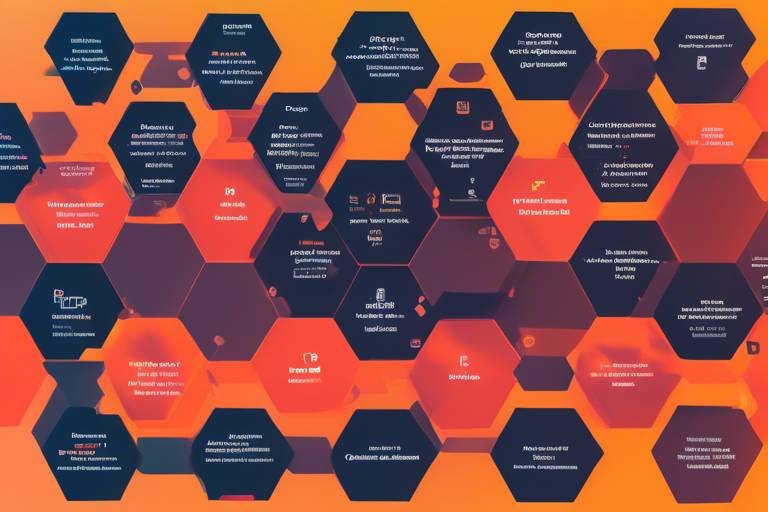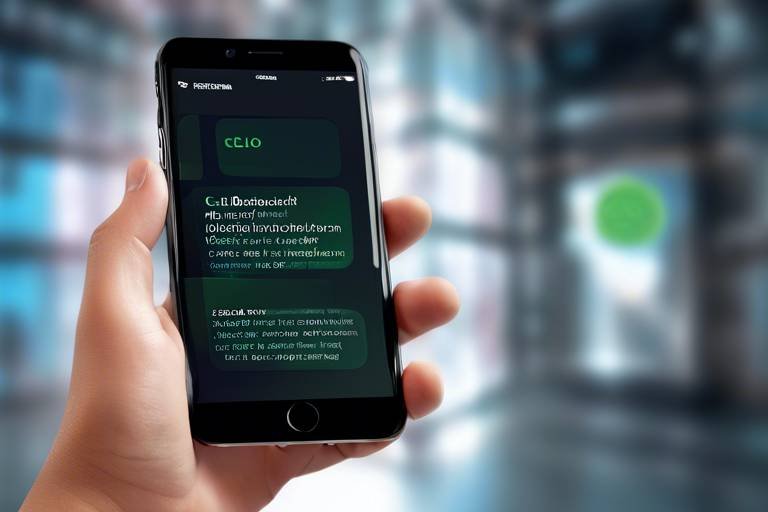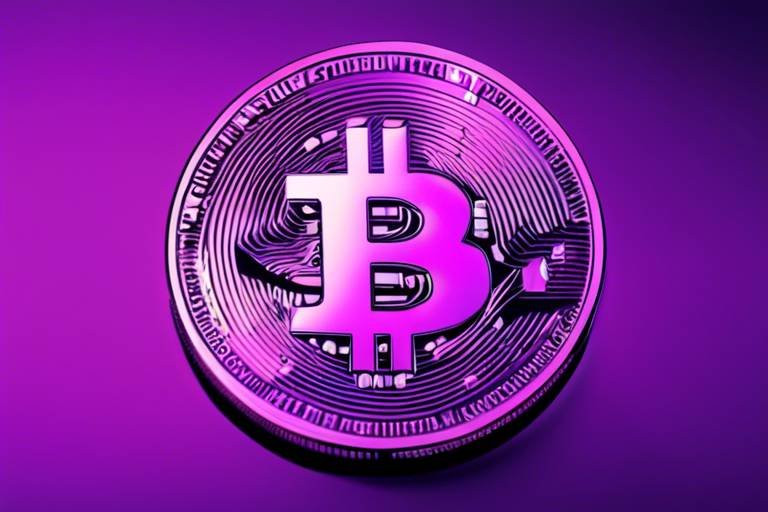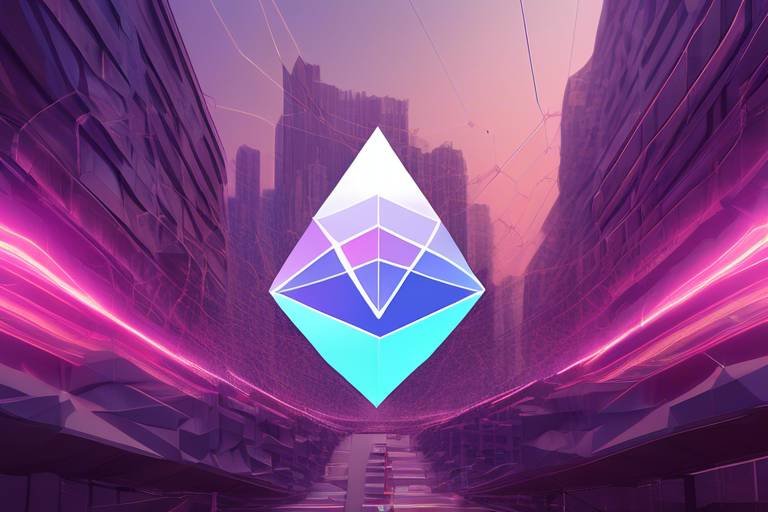Ethereum 2.0 - An In-Depth Look at Its Upgrades
Ethereum 2.0, often referred to as Eth2 or Serenity, marks a significant leap forward in the evolution of the Ethereum blockchain. This upgrade is not just a simple tweak; it's akin to transforming a small pond into a vast ocean, expanding its capabilities and potential. The core aim of Ethereum 2.0 is to enhance the network's security, scalability, and sustainability through a series of innovative upgrades. With the rapid growth of decentralized applications (dApps) and the increasing demand for blockchain technology, Ethereum 2.0 is designed to tackle these challenges head-on, ensuring that the platform remains a leader in the crypto space.
One of the most exciting aspects of Ethereum 2.0 is its transition from a proof-of-work (PoW) consensus mechanism to a proof-of-stake (PoS) model. This shift is not just a technical upgrade; it represents a fundamental change in how transactions are validated and how the network operates. Imagine a bustling city where traffic lights are managed by a few individuals who control the flow of cars. In contrast, Ethereum 2.0's PoS model allows the community to play a role in maintaining order, reducing congestion, and ensuring efficiency. This transition is expected to drastically reduce energy consumption, making the network not only faster but also more environmentally friendly.
The upgrades in Ethereum 2.0 are designed to provide a more user-friendly experience. For instance, with the introduction of sharding—a technique that divides the network into smaller, more manageable pieces—transaction speeds are set to increase significantly. Users will no longer have to endure long wait times or sky-high fees, making Ethereum-based applications more accessible to everyone. This is akin to widening a road to accommodate more traffic; it ensures smoother travel for all users. The combination of PoS and sharding will revolutionize how we interact with blockchain technology, paving the way for a future where decentralized applications can thrive without the limitations of current systems.
As we delve deeper into the intricacies of Ethereum 2.0, it's essential to understand the broader implications of these upgrades. The transition to PoS not only enhances the network's efficiency but also strengthens its security. Validators, who are responsible for confirming transactions, must stake a certain amount of Ether to participate in the network's operations. This creates a financial incentive to act honestly, as any malicious behavior could lead to a loss of their staked Ether. This model fosters a more robust ecosystem where trust is built into the system itself, reducing the reliance on third-party intermediaries.
In conclusion, Ethereum 2.0 is more than just an upgrade; it's a comprehensive overhaul that promises to redefine the landscape of blockchain technology. With its focus on sustainability, scalability, and security, Ethereum 2.0 is poised to become the backbone of a new generation of decentralized applications. As we look ahead, the potential for innovation and growth within this ecosystem is boundless. The future of Ethereum is bright, and as we embrace these changes, we can expect to see a vibrant community of developers, users, and validators working together to build a more decentralized world.
- What is Ethereum 2.0?
Ethereum 2.0 is an upgrade to the Ethereum blockchain that aims to improve its security, scalability, and sustainability.
- How does Ethereum 2.0 differ from Ethereum 1.0?
Ethereum 2.0 transitions from a proof-of-work to a proof-of-stake consensus mechanism, significantly enhancing efficiency and reducing energy consumption.
- What is sharding in Ethereum 2.0?
Sharding is a technique that divides the Ethereum network into smaller pieces, allowing for parallel transaction processing and improved scalability.
- What are the environmental benefits of Ethereum 2.0?
The shift to proof-of-stake reduces the carbon footprint associated with cryptocurrency mining, promoting a more sustainable blockchain solution.

Understanding Ethereum 2.0
Ethereum 2.0, often referred to as ETH 2.0 or Serenity, is not just an upgrade; it’s a transformational leap for the Ethereum blockchain. Imagine the Ethereum network as a bustling city, where every transaction is like a vehicle trying to navigate through busy streets. Over time, as more vehicles (or transactions) enter the city, it becomes congested, leading to delays and inefficiencies. Ethereum 2.0 aims to alleviate this congestion by implementing several key upgrades that enhance security, scalability, and sustainability.
At its core, Ethereum 2.0 is designed to tackle the limitations of its predecessor, Ethereum 1.0. The original Ethereum network operates on a proof-of-work (PoW) mechanism, which is akin to a competitive race where miners solve complex puzzles to validate transactions. This process is not only energy-intensive but also slows down transaction speeds as the network grows. Ethereum 2.0 shifts to a proof-of-stake (PoS) model, which is more like a community board where participants are selected based on the amount of cryptocurrency they hold and are willing to "stake" as collateral. This change significantly reduces energy consumption and increases transaction speeds, paving the way for a more efficient and eco-friendly blockchain.
Furthermore, Ethereum 2.0 introduces a concept known as sharding. Think of sharding as dividing the city into smaller districts, each capable of handling its own traffic independently. This allows the Ethereum network to process multiple transactions simultaneously, greatly enhancing its overall throughput. As a result, users can expect faster transaction times and lower fees, making Ethereum-based applications more accessible and user-friendly.
In addition to these upgrades, Ethereum 2.0 emphasizes security and sustainability. The transition to PoS not only decreases the network's carbon footprint but also encourages a more decentralized approach to network governance. By allowing more participants to play a role in transaction validation, Ethereum 2.0 aims to create a more resilient and robust ecosystem.
Overall, Ethereum 2.0 is set to redefine what blockchain technology can achieve. It’s not just about making transactions faster and cheaper; it’s about creating a platform that is secure, sustainable, and scalable for the future. As we delve deeper into the intricacies of Ethereum 2.0, we’ll uncover how these upgrades will impact developers, users, and the broader blockchain landscape.
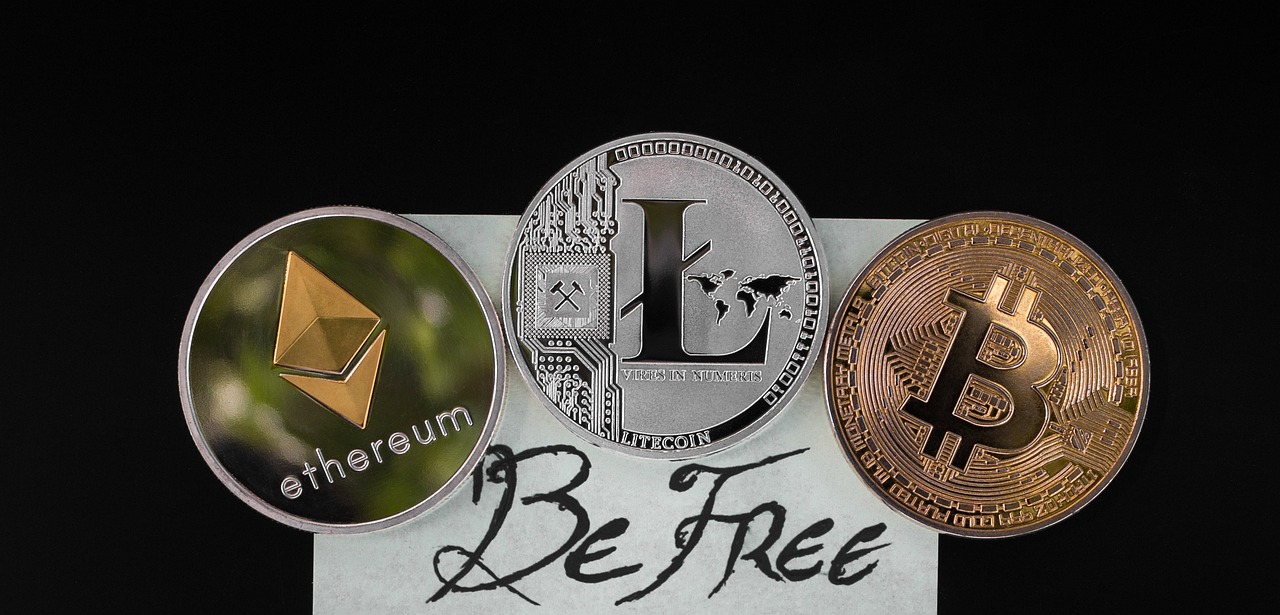
The Transition to Proof-of-Stake
The transition to Proof-of-Stake (PoS) is arguably one of the most groundbreaking changes in the evolution of Ethereum 2.0. Unlike its predecessor, Proof-of-Work (PoW), which relies on energy-intensive mining processes to validate transactions, PoS offers a more sustainable and efficient method of maintaining network security. This shift is not just a minor tweak; it represents a fundamental change in how the Ethereum network operates, aiming to enhance its overall performance while drastically reducing its environmental impact.
So, what exactly does this mean for the average user? Well, PoS operates on the principle that the more Ether you hold, the more likely you are to be chosen to validate transactions and create new blocks. This system encourages users to “stake” their Ether, locking it up as collateral to become validators. As a result, not only does this reduce the reliance on energy-hungry mining rigs, but it also promotes a more decentralized network. The validators are incentivized to act honestly because their stake is on the line; if they try to cheat the system, they risk losing their Ether.
The benefits of this transition are numerous. First and foremost, PoS dramatically decreases the energy consumption associated with blockchain operations. According to estimates, Ethereum's energy usage could drop by over 99% after the full implementation of PoS. This is a significant step toward addressing the environmental concerns that have plagued the cryptocurrency industry. Imagine a world where your digital currency doesn’t contribute to climate change; that’s the vision Ethereum 2.0 is striving for.
Additionally, the transition to PoS enhances the security of the network. In a PoW system, miners compete to solve complex mathematical problems, which can lead to vulnerabilities if a single entity controls a majority of the hashing power. In contrast, PoS makes it much more difficult for any single participant to dominate the network, as doing so would require them to own a significant portion of the total Ether supply. This decentralization is crucial for maintaining the integrity and trustworthiness of the blockchain.
However, the transition to PoS is not without its challenges. One of the primary concerns is the potential for centralization. If wealthier individuals or entities accumulate a large number of Ether, they could dominate the validator pool, which might undermine the very decentralization that PoS aims to promote. To mitigate this risk, Ethereum developers are implementing various mechanisms to ensure a diverse and fair distribution of validators.
In conclusion, the transition to Proof-of-Stake is a pivotal moment for Ethereum. By reducing energy consumption, enhancing security, and promoting decentralization, PoS sets the stage for Ethereum to not only thrive as a blockchain platform but also to lead the charge toward a more sustainable future for cryptocurrencies. As we move forward, the implications of this transition will be felt across the entire blockchain ecosystem, paving the way for innovations that were once thought to be impossible.

Benefits of Proof-of-Stake
The transition from proof-of-work to proof-of-stake (PoS) in Ethereum 2.0 is not just a technical upgrade; it’s a monumental shift that brings a multitude of benefits. Imagine a bustling city where traffic jams are a thing of the past—this is what PoS aims to achieve for the Ethereum network. By allowing validators to confirm transactions based on the number of coins they hold and are willing to 'stake', the network becomes not only more efficient but also more secure.
One of the most notable advantages of PoS is its significantly lower energy consumption. Unlike the energy-intensive mining process of proof-of-work, which requires vast amounts of computational power, PoS operates on a much more sustainable model. This is crucial in an era where environmental concerns are at the forefront of global discussions. In fact, estimates suggest that Ethereum's energy consumption could drop by over 99% post-transition, making it a greener alternative in the cryptocurrency space.
Moreover, PoS enhances transaction speed and overall network efficiency. With PoS, validators are incentivized to act honestly, as their staked Ether is at risk if they engage in malicious activities. This creates a more secure environment where transactions can be processed faster, reducing the time it takes for users to complete their trades or transfers. The result? A smoother experience for everyone involved.
Let’s not forget about network security. In a proof-of-stake system, the more Ether a validator stakes, the more likely they are to be chosen to validate transactions. This means that those with a significant investment in the network have a vested interest in its success. The economic incentives align perfectly, creating a system where bad actors are deterred by the risk of losing their stake. It's like having a neighborhood watch program where everyone has something to lose, fostering a sense of community and responsibility.
To summarize, the benefits of proof-of-stake can be encapsulated in the following key points:
- Lower Energy Costs: Significantly reduces the carbon footprint of the Ethereum network.
- Increased Transaction Speed: Faster confirmation times lead to a better user experience.
- Improved Network Security: Economic incentives align to deter malicious activities.
In conclusion, the shift to proof-of-stake is not merely a technical upgrade; it’s a step towards a more sustainable, efficient, and secure Ethereum ecosystem. The benefits are clear, and as Ethereum 2.0 continues to evolve, the advantages of PoS will only become more pronounced, paving the way for a brighter future in the world of blockchain technology.
Q1: What is Proof-of-Stake?
A1: Proof-of-Stake is a consensus mechanism that allows validators to create new blocks and confirm transactions based on the amount of cryptocurrency they hold and are willing to 'stake' as collateral.
Q2: How does Proof-of-Stake improve energy efficiency?
A2: Unlike Proof-of-Work, which requires extensive computational power and energy, Proof-of-Stake relies on validators who are chosen based on their stake, drastically reducing energy consumption.
Q3: What happens to validators who act maliciously?
A3: Validators who attempt to cheat the system risk losing their staked Ether, which serves as a strong deterrent against dishonest behavior.
Q4: Will transaction fees decrease with Proof-of-Stake?
A4: Yes, with increased efficiency and speed, transaction fees are expected to decrease, making Ethereum more accessible to users.

Environmental Impact
The transition of Ethereum to a proof-of-stake (PoS) consensus mechanism is not just a technical upgrade; it's a significant step towards a more sustainable future for blockchain technology. Traditional proof-of-work (PoW) systems, like the one Ethereum previously used, require massive amounts of energy to validate transactions. This has raised eyebrows and sparked debates about the environmental sustainability of cryptocurrencies. In contrast, Ethereum 2.0's PoS model drastically reduces energy consumption, making it a more eco-friendly alternative.
To put this into perspective, consider this: the energy consumption of PoW can be compared to that of entire countries. For instance, before the transition, Ethereum's energy usage was estimated to be comparable to that of the Netherlands. With PoS, however, the energy consumption could drop by up to 99.95%. This monumental reduction not only lessens the carbon footprint of the Ethereum network but also aligns with global efforts to combat climate change.
Moreover, the environmental benefits extend beyond just energy savings. By promoting a model that requires less computational power, Ethereum 2.0 encourages innovation in green technologies and sustainable practices within the blockchain space. This shift can inspire other projects to follow suit, potentially leading to a ripple effect across the entire cryptocurrency landscape.
However, it's essential to recognize that while the environmental impact is significantly reduced, it does not eliminate all concerns. The focus on sustainability must also include responsible practices among validators and developers. As the network grows, so does the need for ongoing vigilance to ensure that the benefits of PoS are realized without compromising other aspects of environmental stewardship.
In summary, the environmental impact of Ethereum 2.0's transition to proof-of-stake is a game-changer. It not only makes Ethereum more sustainable but also sets a precedent for the entire blockchain industry. By embracing this innovative approach, Ethereum is paving the way for a future where technology and environmental responsibility go hand in hand.
- What is Ethereum 2.0?
Ethereum 2.0 is an upgrade to the Ethereum blockchain aimed at improving its scalability, security, and sustainability. - How does proof-of-stake work?
In proof-of-stake, validators are chosen to create new blocks and validate transactions based on the number of coins they hold and are willing to "stake" as collateral. - What are the benefits of Ethereum 2.0?
Benefits include lower energy consumption, faster transaction speeds, and enhanced network security. - Will Ethereum 2.0 eliminate all environmental concerns?
While it significantly reduces energy consumption, ongoing responsible practices are essential to ensure sustainability.

Validator Responsibilities
In the realm of Ethereum 2.0, validators are the backbone of the network, playing a crucial role in maintaining its integrity and security. Unlike miners in the proof-of-work model, validators are responsible for proposing and attesting to new blocks in the blockchain. This process requires them to lock up a certain amount of Ether (ETH) as a stake, which serves as collateral to ensure that they act honestly. If a validator behaves maliciously or fails to perform their duties, they risk losing a portion of their staked ETH, a mechanism known as slashing.
Validators must remain online and actively participate in the network to fulfill their responsibilities effectively. This means that they need to maintain a reliable and secure server, ensuring that their node is always connected to the Ethereum network. Additionally, validators are tasked with validating transactions and ensuring that they adhere to the network’s rules. This involves checking the validity of transactions, confirming that they do not double-spend funds, and ensuring that the blocks they propose are legitimate.
Moreover, the role of a validator extends beyond just validating transactions. They must also engage in the consensus process, where they vote on the validity of blocks proposed by other validators. This voting mechanism is essential for maintaining a decentralized network, as it prevents any single entity from gaining too much control. The more validators that participate, the more secure and robust the network becomes.
To summarize, the responsibilities of validators in Ethereum 2.0 can be outlined as follows:
- Proposing Blocks: Validators create new blocks to be added to the blockchain.
- Attesting to Blocks: They confirm the validity of blocks proposed by others.
- Maintaining Uptime: Validators must keep their nodes operational to participate in the consensus.
- Participating in Consensus: Engaging in the voting process to secure the network.
- Risk Management: They must manage their staked Ether responsibly to avoid slashing penalties.
In conclusion, the responsibilities of validators in Ethereum 2.0 are multifaceted and crucial for the network's success. By ensuring that they act honestly and efficiently, validators help to create a secure and decentralized blockchain environment that benefits all users.
1. What is the role of a validator in Ethereum 2.0?
Validators are responsible for proposing and attesting to new blocks in the blockchain, ensuring the network's security and integrity.
2. How much Ether do I need to become a validator?
To become a validator, you need to stake a minimum of 32 ETH.
3. What happens if a validator goes offline?
If a validator goes offline, they may miss opportunities to propose or attest to blocks, which can result in lost rewards. Prolonged inactivity can also lead to penalties.
4. What is slashing?
Slashing is a penalty mechanism that reduces a validator's staked Ether if they act maliciously or fail to fulfill their responsibilities.
5. Can anyone become a validator?
Yes, anyone can become a validator as long as they meet the minimum Ether requirement and have the technical capability to run a node.

Challenges of Proof-of-Stake
The transition from proof-of-work to proof-of-stake in Ethereum 2.0 is undoubtedly a revolutionary step forward, but it doesn't come without its own set of challenges. While the benefits are enticing, the hurdles that lie ahead are equally significant. One of the primary concerns is the potential for centralization. In a proof-of-stake system, the more Ether a validator holds, the more influence they have over the network. This could lead to a scenario where a handful of wealthy stakeholders dominate the validation process, undermining the decentralized ethos that blockchain technology is built upon.
Moreover, the security of the network in a proof-of-stake environment is a critical issue. Unlike proof-of-work, where miners must expend significant computational resources to validate transactions, proof-of-stake relies on validators holding a stake in the currency. If a validator acts maliciously, they risk losing their stake, but this creates a paradox: if a few entities control a large portion of the stake, they could collude to manipulate the system. This raises questions about how to ensure robust security measures are in place to prevent such scenarios.
Additionally, the technical complexity of implementing proof-of-stake can pose significant challenges. Transitioning to this new model requires not only extensive coding and development but also thorough testing to ensure that the system can handle potential vulnerabilities. The Ethereum community must remain vigilant and proactive in identifying and addressing these issues as they arise.
Lastly, the educational aspect cannot be overlooked. Many users and developers are accustomed to the proof-of-work model, and transitioning to proof-of-stake may require a steep learning curve. Stakeholders must be educated about how the new system works, the responsibilities of validators, and the implications of staking their Ether. This could lead to a temporary fragmentation of the community as people adjust to the new norms and practices.
In summary, while the transition to proof-of-stake promises numerous advantages for Ethereum 2.0, it also presents significant challenges that must be addressed to ensure a secure, decentralized, and user-friendly blockchain environment. The road ahead is complex and requires collaboration, innovation, and a commitment to the core principles of the Ethereum network.
- What is proof-of-stake? Proof-of-stake is a consensus mechanism that allows validators to confirm transactions based on the amount of cryptocurrency they hold and are willing to "stake" as collateral.
- How does proof-of-stake improve energy efficiency? Unlike proof-of-work, which requires substantial computational power and energy consumption, proof-of-stake reduces energy usage significantly since it doesn't rely on resource-intensive mining.
- What are the risks associated with proof-of-stake? Risks include potential centralization, security vulnerabilities due to collusion, and the need for technical expertise among users and validators.
- How can users participate in proof-of-stake? Users can participate by staking their Ether to become validators or by joining staking pools if they prefer not to run a validator node themselves.

Sharding for Scalability
Sharding is one of the most exciting innovations introduced in Ethereum 2.0, and it's all about making the network faster and more efficient. Imagine a bustling highway during rush hour, where every car is stuck in traffic. Now, picture that same highway divided into multiple lanes, each moving independently. This is essentially what sharding does for the Ethereum network—it divides the blockchain into smaller, manageable pieces called shards, allowing it to process transactions in parallel. By doing so, Ethereum can handle a significantly higher volume of transactions without the congestion that has plagued it in the past.
So, how does this work in practice? Each shard operates like a mini-blockchain, capable of processing its own transactions and smart contracts. This means that instead of a single chain bottlenecking the entire network, multiple shards can operate simultaneously, leading to a smoother and faster user experience. For developers, this opens up a world of possibilities, as they can build applications that are not only more responsive but also more scalable. With sharding, Ethereum can potentially increase its transactions per second from the current rate of around 30 to thousands, making it a powerhouse in the blockchain space.
But let's not forget about the impact on users. With sharding, you can expect faster transaction times and lower fees. Picture this: you're using a decentralized application (dApp) for your daily transactions, and instead of waiting minutes for your transaction to confirm, it happens in seconds. This improvement could encourage more users to engage with Ethereum-based applications, fostering a vibrant ecosystem of innovation and growth.
However, implementing sharding is not without its challenges. It requires careful planning and execution to ensure that the shards can communicate effectively with one another. If one shard experiences issues, it could potentially affect the entire network. Therefore, developers are working diligently to create robust solutions that maintain the integrity and security of the overall system while maximizing efficiency.
In conclusion, sharding is a game-changer for Ethereum 2.0, promising to enhance scalability and improve the user experience significantly. As this technology continues to develop, we can expect Ethereum to solidify its position as a leading blockchain platform, paving the way for a more decentralized and efficient future.
- What is sharding in Ethereum 2.0? Sharding is a method of dividing the Ethereum blockchain into smaller, parallel pieces called shards, allowing for improved transaction processing and scalability.
- How does sharding improve transaction speed? By enabling multiple shards to process transactions simultaneously, sharding reduces congestion and increases the overall throughput of the network.
- Will sharding affect the security of Ethereum? While sharding introduces new complexities, developers are working on solutions to ensure that the network remains secure and reliable.
- When will sharding be fully implemented? The timeline for full implementation of sharding is still being determined, but ongoing developments in Ethereum 2.0 are progressing steadily.

How Sharding Works
Sharding is a groundbreaking technique that enhances the scalability of the Ethereum 2.0 network, allowing it to process a higher volume of transactions simultaneously. Imagine a busy highway that is often congested with traffic; sharding is like adding multiple lanes to that highway, enabling cars to move freely without getting stuck in jams. In the Ethereum context, sharding divides the blockchain into smaller, manageable segments called shards. Each shard operates independently and can process its own transactions, which means that the network can handle many transactions at once, vastly improving efficiency.
To put it simply, think of the Ethereum network as a large office building. Without sharding, all employees (transactions) would have to crowd into one room (the main blockchain) to get their work done. With sharding, each department (shard) has its own workspace, allowing employees to collaborate without interference. This parallel processing capability not only speeds up transaction times but also significantly reduces the congestion that often plagues blockchain networks.
The way sharding works involves several components:
- Shard Creation: The Ethereum network is divided into multiple shards, each capable of processing its own transactions and smart contracts.
- Validator Assignment: Validators are assigned to different shards, ensuring that each shard has a dedicated team to oversee its operations.
- Cross-Shard Communication: Shards can communicate with each other, allowing for transactions that involve multiple shards to be processed smoothly.
This innovative structure not only boosts the overall performance of the Ethereum network but also enhances its security and decentralization. By distributing the workload across various shards, the network becomes less vulnerable to attacks, as compromising one shard does not affect the entire system. Furthermore, sharding allows for a more equitable distribution of resources, making it harder for a single entity to control the network.
In conclusion, sharding is a vital component of Ethereum 2.0 that promises to revolutionize how transactions are processed on the blockchain. By enabling parallel processing and reducing congestion, it paves the way for a more efficient, scalable, and user-friendly Ethereum ecosystem.
Q1: What is sharding?
A1: Sharding is a method of splitting the Ethereum network into smaller parts, or shards, allowing for parallel transaction processing and improved scalability.
Q2: How does sharding improve transaction speed?
A2: By allowing multiple shards to process transactions simultaneously, the overall throughput of the network increases, leading to faster transaction times.
Q3: Will sharding affect the security of Ethereum?
A3: Sharding enhances security by distributing the workload, making it harder for attackers to compromise the entire network since they would need to target multiple shards.
Q4: How does cross-shard communication work?
A4: Shards can communicate with each other to process transactions that involve multiple shards, ensuring that the network remains cohesive while benefiting from the advantages of sharding.
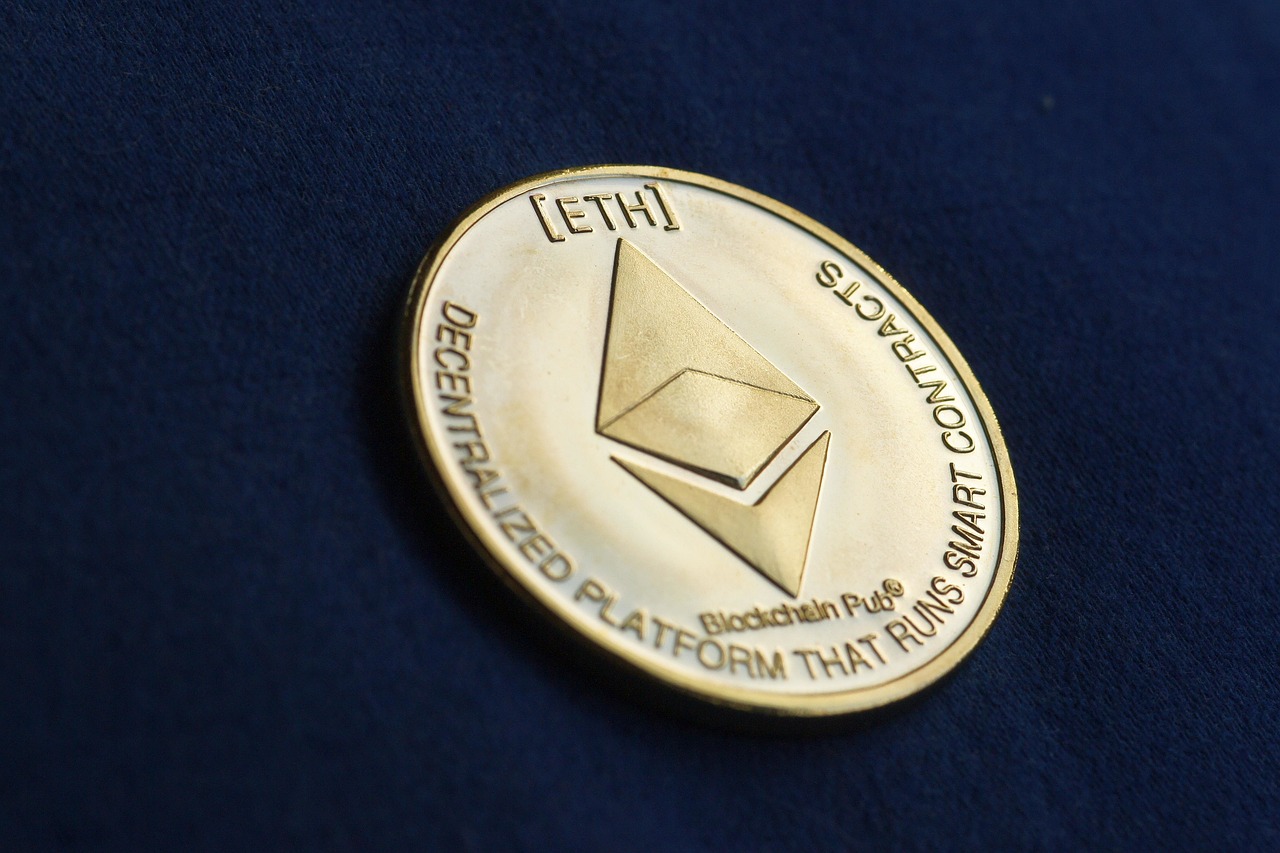
Impact on User Experience
The upgrade to Ethereum 2.0 is not just a technical overhaul; it’s a game-changer for users interacting with the Ethereum blockchain. Imagine navigating a bustling city where traffic flows smoothly, and you can reach your destination without the usual delays. This is the kind of experience Ethereum 2.0 aims to deliver. With the implementation of sharding, the network is set to become significantly more efficient, allowing for faster transaction times and lower fees. No one enjoys waiting for a transaction to confirm, especially when it involves hard-earned money!
To put it simply, the user experience on Ethereum 2.0 is like upgrading from a dial-up internet connection to lightning-fast fiber optics. Transactions that once took several minutes could be confirmed in seconds. This improvement not only enhances user satisfaction but also encourages more people to engage with decentralized applications (dApps) built on the Ethereum platform. Developers can create more complex and interactive applications without the fear of overwhelming the network, leading to innovation that was previously stifled by congestion.
Moreover, the reduction in transaction fees is another crucial aspect that will impact users positively. High fees have been a significant barrier to entry for many potential users and developers. With Ethereum 2.0, users can expect a more affordable experience, making it easier for everyone to participate in the Ethereum ecosystem. This affordability opens up opportunities for a wider audience, allowing small investors and everyday users to engage without worrying about exorbitant costs.
In addition to speed and cost, Ethereum 2.0 also enhances security, which is paramount in the world of cryptocurrency. Users can feel more confident knowing that their transactions are secured by a robust proof-of-stake mechanism, where validators are incentivized to act honestly. This shift not only protects individual users but also strengthens the entire network, fostering a safer environment for all participants.
As Ethereum 2.0 continues to evolve, the user experience will only improve. With ongoing developments and upgrades, users can expect a platform that not only meets their needs but also anticipates them. The future of Ethereum looks bright, and users are in for an exciting ride as they explore the limitless possibilities that this upgraded blockchain has to offer.
- What is Ethereum 2.0? - Ethereum 2.0 is an upgrade to the Ethereum blockchain, aimed at enhancing its scalability, security, and sustainability.
- How does proof-of-stake work? - In proof-of-stake, validators are chosen to create new blocks and confirm transactions based on the amount of cryptocurrency they hold and are willing to "stake" as collateral.
- What is sharding? - Sharding is a method that divides the Ethereum network into smaller pieces called shards, allowing for parallel processing of transactions, which significantly increases throughput.
- Will transaction fees decrease with Ethereum 2.0? - Yes, one of the goals of Ethereum 2.0 is to lower transaction fees, making the network more accessible to users.
- How will Ethereum 2.0 impact developers? - Developers will benefit from improved network efficiency, enabling them to create more complex and interactive dApps without the fear of network congestion.

Future Prospects of Ethereum 2.0
The future of Ethereum 2.0 is not just bright; it's practically glowing with potential! As the blockchain landscape continues to evolve, Ethereum 2.0 is poised to play a pivotal role in shaping the future of decentralized applications and smart contracts. With its innovative upgrades, Ethereum is not merely keeping up with the competition; it’s setting the pace. But what does this mean for developers, users, and the broader blockchain ecosystem?
One of the most exciting aspects of Ethereum 2.0 is its ability to foster a more decentralized and inclusive environment. As more users join the network, the demand for resources will increase, which is where Ethereum's scalability solutions, like sharding, come into play. By allowing the network to handle more transactions simultaneously, Ethereum 2.0 can accommodate a growing user base without sacrificing speed or efficiency. Imagine a bustling city where traffic flows smoothly, and everyone gets to their destination on time—that’s the vision Ethereum 2.0 is striving for!
Furthermore, Ethereum 2.0 is likely to attract a wave of developers eager to build on its robust platform. With enhanced security features and lower transaction costs, developers can create innovative applications that were previously unfeasible. This could lead to a surge in decentralized finance (DeFi) projects, non-fungible tokens (NFTs), and other blockchain-based solutions that could revolutionize various industries.
Another exciting prospect is the integration of layer-2 solutions that work alongside Ethereum 2.0. These solutions aim to improve transaction speed and reduce fees even further. Think of them as express lanes on a highway, allowing vehicles to bypass traffic jams. As these technologies mature, they will enhance the overall user experience and make Ethereum even more appealing to newcomers.
However, it’s essential to keep an eye on the challenges that lie ahead. While the transition to proof-of-stake and the implementation of sharding are groundbreaking, Ethereum must also navigate potential issues like centralization risks and security vulnerabilities. The community's ongoing vigilance and commitment to innovation will be crucial in overcoming these hurdles.
In conclusion, the future of Ethereum 2.0 is not just about technological advancements; it’s about creating a vibrant ecosystem that empowers users and developers alike. With its strong foundation and ambitious roadmap, Ethereum 2.0 is set to redefine what’s possible in the blockchain space. So, buckle up, because the ride is just beginning!
- What is Ethereum 2.0?
Ethereum 2.0 is an upgrade to the existing Ethereum blockchain that aims to enhance its scalability, security, and sustainability. - How does proof-of-stake work?
In a proof-of-stake system, validators are chosen to create new blocks based on the amount of cryptocurrency they hold and are willing to "stake" as collateral. - What is sharding?
Sharding is a method of partitioning the blockchain into smaller, more manageable pieces called shards, allowing for parallel processing of transactions. - Will Ethereum 2.0 reduce transaction fees?
Yes, the upgrades in Ethereum 2.0, particularly sharding and layer-2 solutions, are expected to significantly lower transaction fees.
Frequently Asked Questions
- What is Ethereum 2.0?
Ethereum 2.0, also known as Eth2 or Serenity, is a major upgrade to the Ethereum blockchain that aims to enhance its security, scalability, and sustainability. It introduces significant changes, including a shift from proof-of-work to proof-of-stake, which improves energy efficiency and overall network performance.
- How does the transition to proof-of-stake work?
The transition to proof-of-stake involves validators who are responsible for validating transactions and maintaining the blockchain. Instead of mining, validators are chosen to create new blocks based on the amount of Ether they hold and are willing to "stake" as collateral, thus improving security while reducing energy consumption.
- What are the benefits of proof-of-stake?
Proof-of-stake offers several benefits, including:
- Lower energy costs compared to traditional mining.
- Increased transaction speeds, allowing for quicker confirmations.
- Enhanced network security due to the economic incentives for validators to act honestly.
- What environmental impact does Ethereum 2.0 have?
The shift to proof-of-stake significantly reduces Ethereum's carbon footprint, addressing environmental concerns associated with cryptocurrency mining. This makes Ethereum a more sustainable blockchain solution, appealing to eco-conscious users and developers.
- What is sharding and how does it improve scalability?
Sharding is a technique used in Ethereum 2.0 that divides the network into smaller, manageable pieces called shards. Each shard can process transactions independently, allowing the network to handle more transactions simultaneously, which reduces congestion and enhances overall throughput.
- How will sharding affect user experience?
With sharding, users can expect faster transaction times and lower fees when interacting with Ethereum-based applications. This improvement in performance leads to a smoother and more efficient experience for all users in the Ethereum ecosystem.
- What challenges does Ethereum 2.0 face?
Despite its advantages, Ethereum 2.0 faces challenges such as potential centralization risks, where a small number of validators could dominate the network. Additionally, robust security measures are needed to protect against possible attacks and ensure the integrity of the blockchain.
- What are the future prospects for Ethereum 2.0?
The future of Ethereum 2.0 looks bright, with continuous developments aimed at enhancing its capabilities. As the platform matures, it is expected to solidify its position as a leading blockchain solution, attracting more developers and users to its ecosystem.







